
I made this lasagna for a dear friend whom we were visiting and who couldn’t cook herself because she was recovering from a slipped disc operation. Lasagna is a great dish for such an occasion, because it can be prepared in advance and can simply be heated up in the oven. This will even improve the flavor. My original plan was to make Lasagne alla Bolognese, but when ChgoJohn wrote that he used cream cheese instead of ricotta in his Lasagne dei Bartolini I was intrigued because I had never used either of those in lasagna before. I then learned from Wikipedia and Google ricotta is used in Lasagne alla Napoletana or di Carnevale, and that’s why I decided to make that instead.
Today is Mardi Gras (martedì grasso), the last day of carnival (carnevale) and the traditional dish to eat in southern Italy is Lasagne di Carnevale. You can also eat this lasagna in another time of the year, and then it’s called Lasagne alla Napoletana. Unlike the better known Lasagne alla Bolognese, this lasagna is made with slices of sausage (cervellatine), little meatballs (polpettine) and ricotta, rather than with ground meat and béchamel sauce (besciamella). I find the Napoletana slightly ‘lighter’ or ‘fresher’ in taste as compared to the Bolognese, but of course it is still a filling dish.
Most important for a good Lasagne alla Napoletana is an outstanding Ragù Napoletana, which has to be made with pork only for Lasagne di Carnevale and can be made with a mixture of pork and beef for Lasagne alla Napoletana. Since it takes quite long to make this ragù, it is best to make it the day before.
Another important ingredient that will impart a typical flavor is smoked scamorza or provolone. Smoked scamorza can best be described as smoked mozzarella. It has a distinct shape because it has been hung up with a piece of string to be smoked.
Traditionally, Lasagne alla Napoletana is made with dried durum wheat lasagna sheets that are parcooked. I’ve used fresh pasta made from eggs and durum wheat flour (semola di grano duro rimacinato) instead because it makes the the lasagna more elegant. You could also use dried lasagna sheets that do not need to be cooked, but then you need to make sure that all the sheets are completely submerged in the sauce as they would otherwise stay raw. With parcooked sheets it is okay if some are not submerged in the sauce and become crispy, many people like it that way. But if you don’t parcook the sheets that is another story. Fresh pasta is much easier to handle when parcooked because it doesn’t tear as easily and keeps its shape better.
As with most traditional Italian recipes, there are many variations with each family having its own heirloom recipe. There are variations in the types of soft cheese (mozzarella and/or scamorza), as well as the type of grated cheese (parmigiano or pecorino). Some recipes include slices of hard-boiled eggs as well.
Another difference with Lasagne alla Bolognese I’ve noticed is that most recipes for Lasagne alla Napoletana call for using sheets of dough on the sides of the lasagna as well. My theory is that this is done because otherwise the meatballs will fall out.
This post is also a reminder that when taking photos while cooking, it is important to check the lense now and then… The pictures are still acceptable, but is clear that there was some grease on the lense 😦
Ingredients

For a lasagna dish of 30 x 40 cm (12 x 16 inch), serving 6 to 8
1 preparation of Ragù Napoletana
meatballs (polpettine) made with the meat from the ragù (see below)
sausage from the ragù, sliced
500 grams (2 cups) ricotta (homemade if you like)
1 mozzarella, preferably buffalo, about 125 grams (4-5 oz), diced
1 smoked scamorza or smoked provolone (about 200 grams, 7 oz), diced
freshly grated parmigiano reggiano, about 200 grams (7 oz)
enough lasagna sheets for 4 layers of pasta plus an more for the edges (if made fresh, about 3 eggs plus 300 grams/2 cups flour, semola di grano duro)
butter for buttering the lasagna dish
For the polpettine

400 grams (14 oz) meat from the ragu (beef chuck or pork shoulder, pork ribs without the bones)
3 Tbsp chopped fresh flatleaf parsley
2 eggs
100 grams (3.5 oz) freshly grated parmigiano reggiano
salt and freshly ground black pepper
70 grams (2.5 oz) stale bread without crusts
olive oil for frying
Preparation

Start by taking the meat out of the sauce: pork ribs, beef chuck or pork shoulder, and pork sausages.

You can use a sieve or colander to get most of the sauce off of the meat.

Remove the bones and cartilage from the pork ribs. Rinse the meat under cold water and dry on paper towels.
Reserve the sausages and take 400 grams (14 oz) of the other meat to make the meatballs.

Chop the meat roughly and put in the food processor.

Grind the meat in the food processor. Put the ground meat in a large bowl.

Cut the crust of the stale bread and cut the the bread into pieces.

Put the bread in a food processor.

Add the bread crumbs to the meat in the bowl, together with the eggs, parsley, freshly grated parmigiano, and salt and freshly ground black pepper to taste.
It is a good idea to make a single meatball, fry it, and taste it to make sure the seasoning is right.

Knead this with your hands until homogeneous.
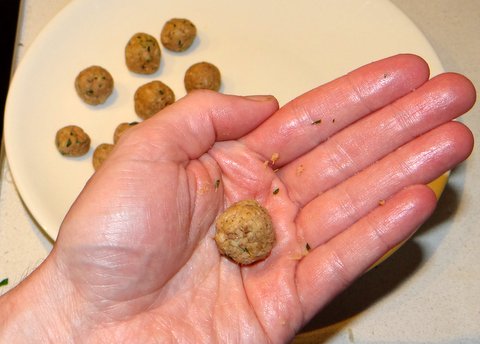
Roll small meatballs with your hands, about the size of a cherry. You can wet your hands to prevent the meat from sticking to your hands.

Continue until you have used up all of the meat.
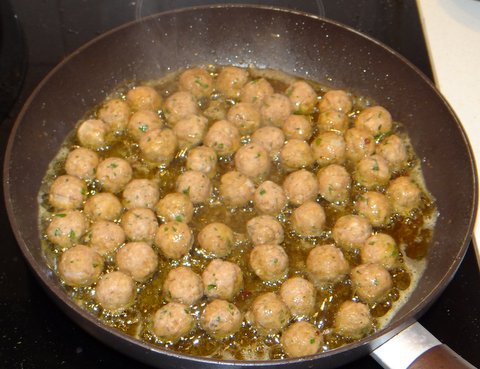
Heat an ample amount of olive oil in a non-stick frying pan over high heat and brown the meatballs in batches (they should easily fit in a single layer at a time).

Sauté the meatballs until browned on all sides.

Remove the meatballs from the pan with a slotted poon.

Drain on paper towels to get rid of any excess oil.
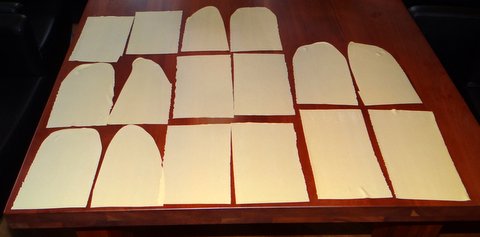
I made fresh pasta, but you could also use dried.

Parboil the lasagna sheets and let them dry on kitchen towels. You can read how in my post on Lasagna alla Bolognese.
Preheat the oven to 180C/350F.
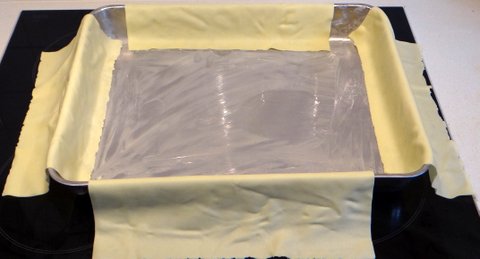
Butter a 30 x 40 cm (12 x 16 inch) lasagna dish. Arrange sheets of dough on the sides as shown. The will be folded on top of the lasagna at the end.

Cover the bottom of the dish with a bit of ragù.

Put the ricotta in a bowl with a bit of the ragù (about 250 ml / 1 cup).

Cover with lasagna sheets, cutting them to size if needed.

Spread out 1/3 of the ricotta mixture.

Spread out 1/3 of the sausage slices, 1/3 f the meatballs, 1/3 of the mozzarella, and 1/3 of the scamorza.

Cover with 1/4 of the remaining ragù.

Sprinkle with freshly grated parmigiano.

Repeat with two more layers, rotating the orientation of the pasta sheets of each layer compared to the previous layer.

Fold over the sheets of dough on the sides, putting a little ragù where the sheets will touch each other.

If needed add another sheet in the center to cover the lasagna completely with sheets of dough.
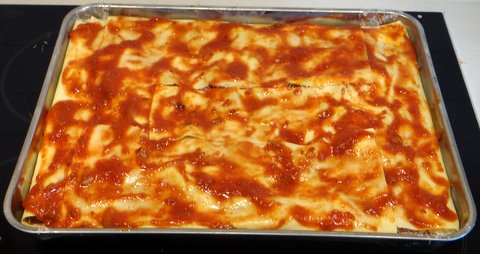
Cover with the remaining 1/4 of the ragù.

Sprinkle liberally with freshly grated parmigiano.

Bake in the oven for 60-90 minutes at 180C/350F until the cheese has melted, the top is golden and everything is warmed through.

Let rest for 5-10 minutes before serving. It is best not to serve the lasagna too hot so you can taste it better.




This is a fantastic lasagna, Stefan, and your post is well-written and full of some great information. The polpettine are just the right size and, for the uninitiated, add an element of surprise to the dish. That opening photo is really a good one, very appealing.
LikeLike
Sorry, Stefan. I hit “enter” before I thanked you for the shout-out. 🙂
LikeLike
Thanks. I always find it difficult to get good photos of oven dishes like lasagne.
LikeLike
Che Meraviglia Stefan, amazing! You have such patience too … your cherry-sized polpette are truly a labour of love. I am sure your lasagne went a great way to helping your friend recover … lucky friend!
LikeLike
Thanks. The polpettine were definitely a lot of work, but they were the right size for the lasagne.
LikeLike
Lovely lasagne Stefan. My Italian friend Peter Borza tells me that this is how they have always made their lasagne. He is about my age and remembers, in his childhood, himself and his brother and sister rolling the meatballs for the lasagne. His mum promises to give me a pasta making lesson one of these days. I can’t wait.
Best,
Conor
LikeLike
He is probably from the south of Italy then. Would be great to get such a lesson! After this weekend you’ll be able to tell the difference with how I make pasta 🙂
LikeLike
Excellent. Looking forward to it.
LikeLike
Another wonderful post, Stefan. Lovely meal, beautifully done. I imagine it was absolutely delicious.
LikeLike
It was and I will definitely make it again, even if it is a lot of work. Thanks for the nice words.
LikeLike